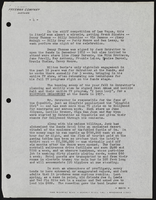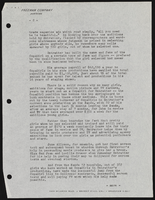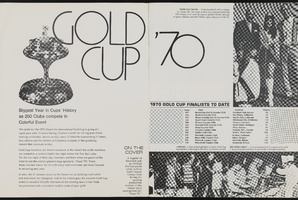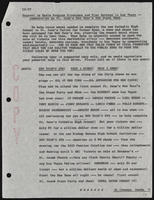Search the Special Collections and Archives Portal
Search Results

Film transparency of tornado victims, Nevada, 1931
Date
1931
Archival Collection
Description
From left to right, tornado victims Mrs. Joe Leavy, three-year old (Baby) Bell, and what is presumed to be Joe Leavy in Midway City, Nevada. Midway City, now known as Henderson, is located eight miles out of the Hoover Dam highway.
Image
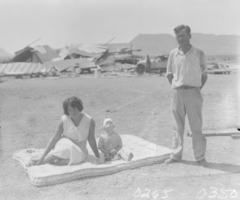
Film transparency of tornado victims, Nevada, 1931
Date
1931
Archival Collection
Description
From left to right, tornado victims Mrs. Joe Leavy, three-year old (Baby) Bell, and what is presumed to be Joe Leavy in Midway City, Nevada. Midway City, now known as Henderson, is located eight miles out of the Hoover Dam highway.
Image

Pedestrian and automobile traffic on the Las Vegas Strip, Las Vegas, Nevada: digital photograph
Date
2017-02-28
Archival Collection
Description
Providing security and access to both automobile and pedestrian traffic is handled differently along Las Vegas Boulevard and has changed over the years on the Strip. Here tourist utilize a spacious sidewalk in front of the Paris Las Vegas hotel and casino as the Bellagio is seen in the background.
Image
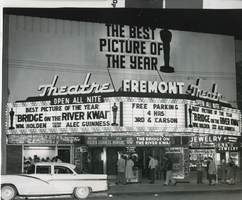
Photograph of the Fremont Theatre marquee advertising "Bridge on the River Kwai," Las Vegas (Nev.), 1957
Date
1957
Archival Collection
Description
Black and white image of the Fremont Theatre marquee reads: "Best Picture Of The Year 'Bridge On The River Kwai' MW. Holden Technicolor Alec Guinness; Free Parking 4Hrs 3RD & Carson." Site Name: Fremont Theatre (Las Vegas, Nev.)
Image
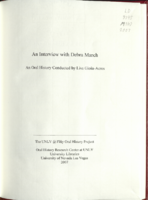
Transcript of interview with Debra March by Lisa Gioia-Acres, February 21, 2007
Date
2007-02-21
Archival Collection
Description
Debra March was born in Detroit, Michigan, in 1953. She is one of eight siblings all of whom attended Catholic school as children and eventually went on to professional careers. Debra's father worked for the city of Detroit, then moved to Las Vegas and was hired by the Clark County School District. He ultimately retired from there. Debra came to Las Vegas for the first time in 1973. Though she left for a couple of years, she eventually settled here and attended UNLV, earning an undergraduate degree in anthropology and biology. She then served a little over six years as a park ranger in Red Rock and Lake Tahoe. While at Lake Tahoe, Debra got her real estate license. She followed her husband to Ely, where she became a social worker. She ran the welfare division for rural Nevada in several counties and also kept her real estate license active. In 1989, Debra applied for the position of administrator of the Nevada Real Estate Division in Las Vegas. In her capacity as deputy administrator, Debra oversaw the activities of individuals who sold real estate. She and others in the division also monitored land sales time-shares, campground memberships and appraisers. She served in that position for four and a half years. In 1996, Debra was hired at UNLV. Many of the faculty members in the real estate school today are the ones who were there when she was hired, such as Mike Clauretie, Dick Hoyt, and Bob Aalberts. The Lied Institute, which she directs, supports an academic program in real estate and finance. It also conducts research, addresses community issues such as affordable housing, and offers adult and executive education programs. Debra is very involved in addressing many of the problems of housing and transportation that affect everyone living in the valley. In addition to heading the Lied Institute, she is also a Henderson planning commissioner, serves on the National Board of the American Planning Association, and is vice chairman of the board of the Urban Land Institute. She is proud of having established a real estate mentoring program that matches students with industry professionals, and she works closely with students to help them with their career goals.
Text

Transcript of interview with Herbert C. Wells by Dr. David Emerson, March 8, 2006
Date
2006-03-08
Archival Collection
Description
Herbert C. Wells is currently professor emeritus of civil and environmental engineering at UNLV, and is considered the father of engineering at the university. He was born in Omaha, Nebraska, in 1927, and spent the first four years of his life there. After his father was killed in a plane crash in 1931, his mother moved them out to Los Angeles to be near her husband's parents. They moved several times, but the goal was always to find good schools for Herb and his sister Herb received an outstanding junior high education at Trailfinders School for Boys, and then attended Woodrow Wilson Junior High School in ninth grade. He then was sent to the San Diego Army Navy Academy, where he completed high school in two years and graduated at age 16. He next enrolled at Pasadena Junior College, majoring first in chemistry and then in geology, and was drafted into the army at age 18. After the war, Herbert returned to Berkeley to finish his education. The GI bill helped him finish his master's degree. He then went to work for United Geophysical for two years, and following that, was hired at a mine in Climax, Colorado. He and his second wife moved to Las Vegas in 1957, where he began working for Titanium Metals. After a mere three weeks on the job, he met with Dr. Malcolm Graham from early UNLV, who asked Herb to teach surveying. Dr. Wells taught surveying for only one semester, but continued his association with the faculty at the university. He kept working at Titanium Metals, where he learned a lot of practical chemistry, but was laid off shortly thereafter. He then was offered a job with Blue Diamond Gypsum as a plant engineer and continued teaching on a part-time basis. He became a full-time instructor at the college in 1961. By 1967, Herbert had been appointed chairman of science, math, and engineering. He immediately put in a request for ten more teaching positions, which were ultimately filled. He also was instrumental in putting together a proposal for a graduate degree in physics, and of course was involved in ABET accreditation for engineering degrees.
Text
Pagination
Refine my results
Content Type
Creator or Contributor
Subject
Archival Collection
Digital Project
Resource Type
Year
Material Type
Place
Language
Records Classification

